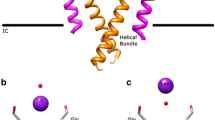Abstract
The Xenopus oocyte expression system in combination with patch-clamp techniques allows the measurement of ionic currents from a single class of genetically engineered ion channels. Ionic currents in the nanoampere range from oocytes injected with cRNA, corresponding to potassium channels, can be recorded in the inside-out patch configuration. These recordings have a high time resolution at low background noise. Substitution of impermeant ions for potassium and blocking of the channel conductance with tetraethylammonium allows the recording of potassium gating currents, I g, which is hampered in natural excitable cells by the simultaneous presence of sodium channels and a variety of different potassium channels. The “on” transients, I ong , are fast and can have amplitudes of up to several tens of pA. Upon repolarization to -100 mV after small depolarizations, “off” gating currents, I offg , which reverse most of the “on” charge displacement, Q on, within 1 ms, are readily observed. However, this fast recovery of the gating charge is drastically reduced upon increasing the amplitude of the depolarizing pulse. In contrast to sodium channels, this temporary charge immobilization is complete within a few milliseconds at positive membrane potentials. Furthermore, there seems to be no direct correlation between charge immobilization and inactivation because the same phenomenon occurs for channels that do not inactivate.
Similar content being viewed by others
References
Almers W, Armstrong CM (1980) Survival of K+ permeability and gating currents in squid axons perfused with K+-free media. J Gen Physiol 74:61–79
Armstrong CM, Bezanilla F (1973) Currents related to the gating particles of sodium channels. Nature 242:459–461
Armstrong CM, Bezanilla F (1977) Inactivation of the sodium channel: II. Gating current experiments. J Gen Physiol 70:567–590
Augustine CK, Bezanilla F (1990) Phosphorylation modulates potassium conductance and gating current of perfused giant axons of squid. J Gen Physiol 95:245–271
Baumann A, Grape A, Ackermann A, Pongs O (1988) Structure of the voltage-dependent potassium channel is highly conserved from Drosophila to vertebrate central nervous systems. EMBO J 7:2457–2463
Begenisich T (1979) Conditioning hyperpolarization-induced delays in the potassium channels of myelinated nerve. Biophys J 27:257–266
Bezanilla F, White MM, Taylor RE (1982) Gating currents associated with potassium channel activation. Nature 296:657–660
Conti F, Stühmer W (1989) Quantal charge distributions accompanying the structural transitions of sodium channels. Eur Biophys J 17:53–59
Conti F, Inoue I, Kukita F, Stühmer W (1984) Pressure dependence of sodium gating currents in the squid giant axon. Eur Biophys J 11:137–147
Gundersen CB, Miledi R, Parker I (1983) Voltage-operated channels induced by foreign messenger mRNA in Xenopus oocytes. Proc R Soc Lond [Biol] 220:131–140
Hodgkin AL, Huxley AF (1952) A quantitative description of membrane current and its application to conduction and excitation in nerve. J Physiol (Lond) 117:500–544
Keynes RD, Rojas E (1974) Kinetics and steady-state properties of the charged system controlling sodium conductance in the squid giant axon. J Physiol (Lond) 239:393–434
Kramer W, Drutsa V, Jansen H-W, Kramer B, Pflugfelder M, Fritz H-J (1984) The gapped duplex DNA approach to oligonucleotide-directed mutation construction. Nucleic Acid Res 12:9441–9456
Lichtinghagen R, Stocker M, Wittka R, Boheim G, Stühmer W, Ferrus A, Pongs O (1990) Molecular basis of altered excitability in Shaker mutants of Drosophila melanogaster. EMBO J 9:4399–4407
Methfessel C, Witzemann V, Takahashi T, Mishina M, Numa S (1986) Patch clamp measurements on Xenopus laevis oocytes: currents through endogenous channels and implanted acetylcholine receptor and sodium channels. Pflügers Arch 407:577–588
Meves H (1974) The effect of holding potential on the assymetry currents in squid giant axons. J Physiol (Lond) 243:847–867
Nonner W, Rojas E, Stämpfli R (1975) Asymmetrical displacement currents in the membrane of frog myelinated nerve. Pflügers Arch 375:75–85
Pongs O, Kecskemethy N, Müller R, Krah-Jentgens I, Baumann A, Kiltz HH, Canal I, Llamazares S, Ferrus A (1988) Shaker encodes a family of putative potassium channel proteins in the nervous system of Drosophila. EMBO J 7:1087–1096
Schauf CL, Bullock OJ (1979) Modifications of sodium channel gating in Myxicola giant axons by deuterium oxide, temperature, and internal cations. Biophys J 27:193–208
Spires S, Begenisich T (1989) Pharmacological and kinetic analysis of K channel gating currents. J Gen Physiol 93:263–283
Stocker M, Stühmer W, Wittka R, Wang X, Müller R, Ferrus A, Pongs O (1990) Alternative Shaker transcripts express either rapidly inactivating or non-inactivating K+ channels. Proc Natl Acad Sci USA 87:8903–8907
Stühmer W, Methfessel C, Sakmann B, Noda M, Numa S (1987) Patch clamp characterization of sodium channels expressed from rat brain cDNA. Eur Biophys J 14:131–138
Stühmer W, Stocker M, Sakmann B, Seeburg P, Baumann A, Grupe A, Pongs O (1988) Potassium channels expressed from rat brain cDNA have delayed rectifier properties. FEBS Lett 242:199–206
Stühmer W, Conti F, Suzuki H, Wang X, Noda M, Yahagi N, Kubo H, Numa S (1989) Structural parts involved in activation and inactivation of the sodium channel. Nature 339:597–603
White MM, Bezanilla F (1985) Activation of squid K+ channels. J Gen Physiol 85:539–554
Zagotta WN, Aldrich R (1990) Voltage-dependent gating of Shaker A-type potassium channels in Drosophila muscle. J Gen Physiol 95:29–60
Author information
Authors and Affiliations
Rights and permissions
About this article
Cite this article
Stühmer, W., Conti, F., Stocker, M. et al. Gating currents of inactivating and non-inactivating potassium channels expressed in Xenopus oocytes. Pflugers Arch. 418, 423–429 (1991). https://doi.org/10.1007/BF00550881
Received:
Revised:
Accepted:
Issue Date:
DOI: https://doi.org/10.1007/BF00550881




